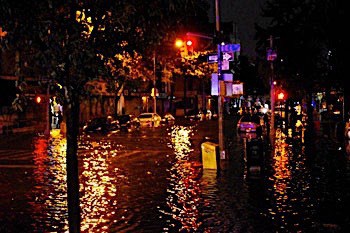 As more schools on the storm-ravaged East Coast reopened this week, some school officials remained concerned about fuel supplies for school buses.
As more schools on the storm-ravaged East Coast reopened this week, some school officials remained concerned about fuel supplies for school buses.
The Federal Motor Carrier Safety Administration announced on Monday that it would lead an Interstate Petroleum Transport Team to ensure a rapid and efficient movement of fuel to hard-hit areas. The team will serve as a single point of contact for states, the trucking industry and other agencies to assist in removing barriers to fuel delivery.
“This team will help get fuel delivered to states and communities recovering from Hurricane Sandy even faster and more efficiently than before, by streamlining multiple state regulations for trucks,” said Transportation Secretary Ray LaHood.
Though New York City Mayor Michael Bloomberg told reporters Friday that the fuel-supply issues were starting to improve, school districts in the Hudson Valley and Rockland County have cut back their bus routes. Many Hudson Valley schools reopened Monday after officials worked nonstop last weekend to ensure there would be enough fuel for buses and for power in schools. The Hudson Valley runs north to south down the eastern edge of New York State.
Transportation Coordinator Shawn Frederick of Pearl River School District in the Hudson Valley said they closed schools the week after the storm and the fuel shortage directly impacted the kind of bus service they could offer upon reopening Monday. Much of their operation is contracted out to Chestnut Ridge Transportation and Vel Coach, but the department operates two routes.
“We could only provide transportation to our small district’s geographical area and not the other 45 schools outside of our area because we were fearful we couldn’t get through the day,” said Frederick. “We filled up all our buses on Oct. 26, the day before Sandy hit, and then we lost power and we couldn’t get any gas out of the ground … so we finally got a generator.”
He noted that Vel Coach also filled up their seven smaller, 20-passenger school buses the day before the storm. Still, the district could only plan for her operation to run within the district.
“We were one of the few schools in our area that opened Nov. 5. Many just opened up Wednesday,” Frederick said. “Fortunately, our local public transportation ran all their bus routes free for the whole week. So a lot of people who normally don’t take the bus could ride it.”
That includes many high school students who lost school bus service last year when the district increased the eligibility distance to three miles, he explained, moving 400 to 500 kids off the buses. Some of these students now take transit buses to school.
“It’s been a big challenge for us here. It’s getting better for the larger gas stations that are part of a company-owned distribution network, like an Exxon station. It’s harder for some of the local stations that get fuel from a secondhand distributor, because they have contracts with independent fuel distributors and those guys are having trouble getting it. So that’s not all fixed,” he said.
“One reason we talked to BOCES the other morning is that some of the gas stations we use for other district vehicles are still out of gas,” he added. “The problem has been solved more for the general public, but for fuel-centered businesses like ours, it’s a struggle. We’re caught up now.”
Better Prices Over the State Line
In nearby New Jersey, Pearl River and South Orangetown school districts are in the same position. They too can only provide school bus service to in-district students because of fuel shortages.
“Private bus companies have limited supplies,” South Orangetown Superintendent Ken Mitchell said. “Some also have power issues and cannot draw from their tanks.”
A week after Superstorm Sandy, the price of gas increased 10 cents per gallon or more in the New York City area and 14 cents more in Nassau County, on Long Island. In Bergen County, located in northeast New Jersey, motorists will pay about 13 cents more per gallon.
But Frederick said that fuel prices in the Hudson Valley didn’t increase as much — just 5 or 10 percent. He has the advantage of being located right on the border of New Jersey, where prices are generally 40 cents a gallon cheaper than in New York.
“Our contractors go into New Jersey to get gas, and we don’t have to pay New York State tax on it. Pricewise, we don’t have a problem — but it’s just getting it,” he continued, noting they primarily use diesel. “We arranged with BOCES to have them as a backup for fuel.”
He stressed that the fluctuating price of fuel was a problem for his district and others in the valley long before the superstorm. In a recent STN survey of transportation directors and supervisors, 23 percent of respondents said fuel is their largest budget item, second only to employee salaries and benefits.
Marge Feinberg, spokeswoman for New York City Public Schools, told STN she was not aware of any problems with the city’s school transportation due to fuel supplies. Many high school students there rely on mass transit to get to school.
“We don’t foresee any fuel shortage impacts on student transportation,” Feinberg said. “Most of our schools reopened Monday. Some are still closed because of structural damage from the storm but may reopen [Wednesday].”
















